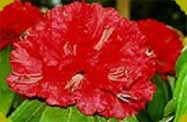|
Centella asiatica
Linn.

|
Species |
Centella asiatica
Linn. |
|
Local Name |
Golpatta, Attaney (Nep) |
|
Synonym |
Hydrocotyl asiatica
Linn. |
|
Family |
Apiaceae, Umbelliferae |
|
Habitat |
It is a small herbaceous plant creeping on the ground
particularly during rainy season. Common in moist shady
places all over India. |
|
Distribution |
Distributed in temperate and tropical areas, 400- 1500
m. |
|
Sikkim |
Hee- Gyathang to Dikchu, Pentong to Sakyong, Dentam,
Gangtok, Rongli to Padamchen. |
|
Out side |
West Bengal (Darjeeling, Kalimpong, Rongbe Chu, Rangit
river, Torsa River), Cereal, Gujarat, Punjab, Andhra
Pradesh. |
|
General |
|
|
Morphological |
A prostrate, faintly aromatic, stoloniferous perennial
herb up to 2 m long, commonly found as a weed in crop
fields and other waste places throughout India. Stem
glabrous, pink and striated, rooting at the nodes.
Leaves fleshy, orbicular- reniform, crenate dentate,
base cordate and often lobed, long petioled, smooth on
the upper surface and sparsely hairy on the lower;
flowers red, pink or white, in fascicled umbels; fruits
oblong, dull brown, laterally compressed, pericarp hard
and thickened, woody, white, in fascicled umbels;
fruiting oblong, dull brown, laterally compressed,
pericarp hard and thickened, woody, white. |
|
Flowering |
April-May |
|
Fruiting |
May-August |
|
History |
|
|
Parts |
Whole plant, leaves. |
|
Status |
Low risk |
|
Phytochemistry |
|
|
Agrocultivation |
The plant is propagated from seeds or from stolons. |
|
Reference |
1. Anonymous (1961). The Wealth of
India (Vol. 3). Publications and Information
Directorate, CSIR. New Delhi, 428- 430.
2. Anonymous (1992). The Useful
Plants of India. Publications and Information
Directorate, CSIR. New Delhi, 115, 161- 164.
3. Bhujel, R.B. (1996). Studies on
the Dicotyledonous Flora of Darjeeling District.
Unpublished PhD Thesis University of North Bengal. 368.
4. Grierson, A.I.C. & D.G. Long
(1999). Flora of Bhutan (Vol. 2, Part 2). Royal Botanic
Garden, Edinburgh, 446.
%5. Handa, S.S. and M.K. Kaul.
Supplement to Cultivation and Utilization of Medicinal
Plants. Regional Research Laboratory Jammu Tari. 36.
6. Progress Report of the Project
“Studies on Medicinal Plants of Sikkim” (1988 – 2001).
7. Thakur, R.S., H.S. Puri, Akhtar
Hussain (1989). Major Medicinal Plants of India. Central
Institute of Medicinal and Aromatic Plants. Lucknow. |
|
Medicinal |
|
|
Ayurvedic |
The important preparation made from this are "Brahmi
Gharitam", 'Sarasuarista" and "Brahmi Rasayana".
Mandukaparni is considered one of Rasayana
(rejuvenating) drugs and is used to make the colour of
the body fair, to improve memory and to prolong the life
span. The whole plant is used for external application
as well as for internal administration. Mixed with milk
or the decoction boiled in ghee may also be given along
with Glycyorrhiza glabra is used externally, in the form
of powder, plaster, ointment, water bath or infusion, it
is used for treating skin disease of varied nature such
as chronic and obstinate ulcers, eczema, psoriasis and
leprous wounds. |
|
Unani |
|
|
Traditional |
Leaf extract (juice) is popular
medicine for gastritis. A glassful of juice taken every
morning in empty stomach as toxic and stimulant and
increase memory power (Project report). |
|
Others |
The plant is valued in indigenous
medicine for treatment of leprosy and skin diseases and
also to improve memory. The plant is used as an antidote
to cholera. A cold poultice of the fresh herb is used as
an external application in rheumatism, elephantiasis and
hydrocele.
Syrup of the leaves with ginger and
black pepper is taken for cough. Leaf juice with palm
jaggery is given to women as a tonic after delivery. The
leaf juice is rubbed on the forehead to cure severe
headache. The leaf extract is used in the preparation of
medicated oil for bone fracture. The leaves are
diuretic. Pills prepared from the paste of leaves of the
plant and Ocimum sanctum and black pepper are used in
the treatment of intermittent fever. |
|
Prepartation |
|
|
Picture |
|
|
|
|
|

Rhododendron


Amongst the many
floral treaties of Sikkim Himalaya one of the earliest ones may be
found over the genus Rhododendron (Gk. rhodo = red, dendrons = tree
). |
| |
|
|
|

Orchid


Orchid
known for their brilliance in colors, unusual shapes
attractive growth habits, variety in fragrance and
exquisite beauty can attract any nature lovers.
|
| |
|
|
|

Medicinal Plant


Sikkim
with its total geographical area of 7,096 sq km is
bestowed with a huge diversity of flora and fauna.
|
| |
|
|
|
|
|